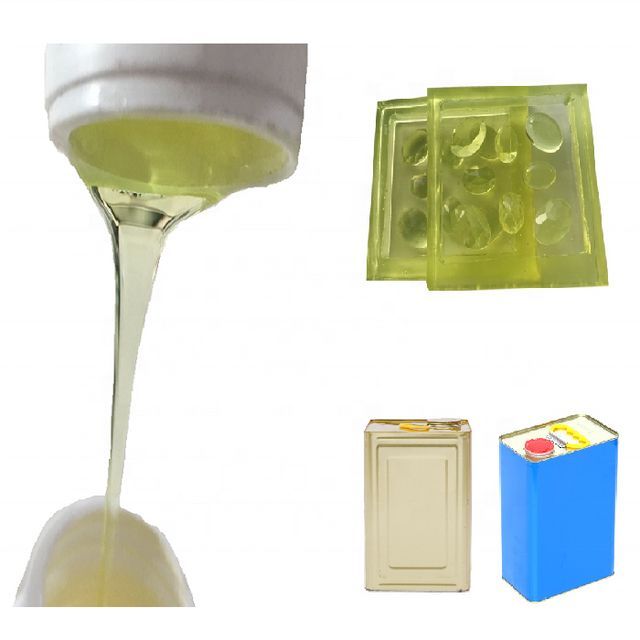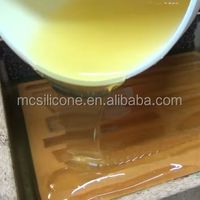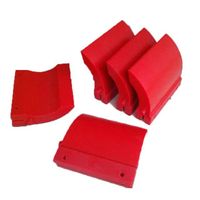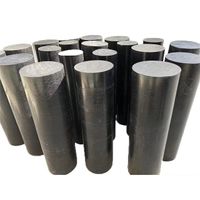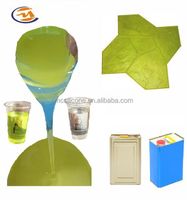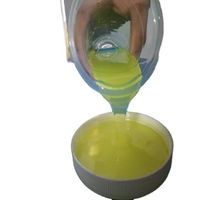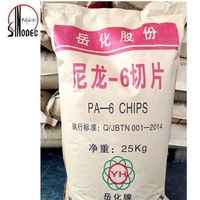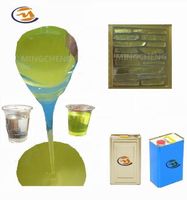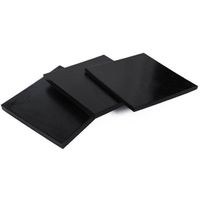Clear Yellow Two-Component Liquid Polyurethane Rubber Casting/Mold Making Liquid Polyurethane Rubber
- $5.98 / >=120 kilograms
- 120 kilograms
- Dongguan Mingcheng Electronic Technology Co., Ltd.
- Guangdong, China
- Ms Amy Tse
Product Detail
| Package preview: | payment terms: | L/C, Western Union, T/T, MoneyGram, PayPal | |
| model: | MC-PU80 | Packaging Details: | 20Kg/barrel; 200kg/barrel |
| Origin: | Guangdong, China | Supply capacity: | 4000 kg per day |
| product name: | Two-component liquid polyurethane rubber | type: | Polyurethane |
| hardness: | 80 Shore A | mixing ratio: | 1:1 |
| brand: | mc silicone | Viscosity: | 2500 centipoise |
| Applicable period: | 8~14 minutes | application: | Mold Making/Casting Rubber Roller |
| tensile strength: | 9~14 MPa | Curing time: | 24 hours |
| port: | Shenzhen | Tear Strength: | 50~60N/mm |
| elongation: | 350~550% |
Liquid polyurethane rubber product description
Liquid polyurethane rubber is composed of components A & B, B is a vulcanizing agent, and A is a polyurethane prepolymer. It can also be used as concrete or cement stamping dies, and to make hard and durable rubber parts for mechanical or automotive applications.
Characteristics of liquid polyurethane rubber:
It has excellent processing performance, is solid at room temperature, and has a short gelation time. The color can be adjusted by adding pigments. The product has good wear resistance, hydrolysis resistance, transparency, good resilience and stable size.
Application of liquid polyurethane rubber:
Instead of silicone rubber to make "cultural stone" molds. It is also suitable for electrical equipment potting, rubber rollers, skis, snowboards, rubber sheets, rubber wheels, shoe molds, etc.
|
A |
type |
MCU 40A |
single chip microcomputer50 |
single chip microcomputer60 |
single chip microcomputer70 |
single chip microcomputer80 |
single chip microcomputer90 |
|
appearance |
Colorless or light yellow transparent liquid |
||||||
|
viscosity(30℃) mPa·s/ |
2500±300 |
||||||
|
Second |
type |
MCU 40Second |
single chip microcomputer50Second |
single chip microcomputer60Second |
single chip microcomputer70Second |
single chip microcomputer80Second |
single chip microcomputer90Second |
|
appearance |
light yellow liquid |
||||||
|
Viscosity (30℃)/mPa·s |
560±200 |
||||||
|
Ratio A:B (mass ratio) |
1:1 |
||||||
|
appearance |
light yellow |
||||||
|
Operating temperature/℃ |
25~40 |
||||||
|
Gel time (30℃)*/minute (Changing) |
25-30 |
25-30 |
25-35 |
20-30 |
8-14 |
6-9 |
|
|
Hardness (Shore A) |
40±3 |
50±3 |
60±3 |
70±3 |
80±3 |
90±3 |
|
|
Tensile strength/MPa |
4-7 |
5-8 |
5-8 |
8-11 |
9-14 |
18-25 |
|
|
Elongation at break/% |
500-600 |
400-500 |
300-400 |
250-350 |
350-550 |
400-500 |
|
|
Tear strength/(kN/m) |
18-22 |
18-22 |
20-25 |
26-30 |
50-60 |
70-85 |
|
|
Rebound rate/% |
30-35 |
30-35 |
30-35 |
30-35 |
36-40 |
32-35 |
|
|
proportion(25℃)(g/cm3) |
1.18 |
||||||
Instructions:
mix:
1. Shake sides A and B vigorously. Shake or stir well before use Liquid ingredients may settle in container during storage. Let it sit for a few minutes to allow any air bubbles to rise to the surface after shaking the container.
2. Measure equal volumes of A and B into a clean plastic or metal container.
Combine both sides into a third clean mixing container and mix vigorously for at least one minute, taking care to scrape the sides and bottom of the mixing container with the mixing utensil, until the product is uniform in color.
noPrecautions:
1. Always wear a respirator or self-contained breathing apparatus when using polyurethane.
2. Use in a humidity controlled environment between 65F and 75F.
3. It is always best to mix materials by hand with a plastic or metal mixing utensil. Avoid mixing with motor drills as they create friction and mixing with an electric drill will start the exothermic curing process and cause the product to cure in the mixing container.
4. Do not change the mixing ratio. Changing the mix ratio to change the cure cycle does not work with polyurethanes, unlike some polyester resins.
5. Mix in a clean plastic container. Paper cups and wooden stirring utensils can contain moisture, which can adversely affect urethane rubber. Avoid waxed paper cups, as the wax may melt and stain the rubber.
6. Bubbles in polyurethane are almost always caused by moisture. Do everything possible to keep moisture out of the mixture.
7. Put the lid on the container immediately after use. Do not use urethane rubber in rainy weather or when there is high humidity.
8. Avoid pouring on unsealed water-based products such as plaster or hydrocal. Seal the plaster or hydrocal with a product such as Krylon Clear Acrylic.
9. Avoid mixing large batches – the larger the batch size, the more exotherm or heat will be generated during the cure cycle. If you're making large molds, mix up small batches to make the process more manageable.
Storage of liquid polyurethane rubber:
Store in a cool dry place. If you can't use up a bucket at a time, inject N2. The storage period in the original packaging is 6 months.
1. Recap the bottle immediately after use.
2.Extend-It aerosol nitrogen blanket can be used to protect products from moisture contamination.
Package:20Kg/barrel or 200Kg/barrel.

Related Products
-
High quality 40 Shore A mold making liquid polyurethane rubber for making plaster molds
Applicable period: 20-25 minutes Tear Strength: 18~22N/mm Package Preview: type: Polyurethane hardness: 40 Coast Payment Terms: L/C, Western Union, T/T, MoneyGram Origin: China model: MC-PU40A/B appearance: Light yellow liquid Curing time: 24 hours Supply Ability: 4000 kg per day Viscosity: 2500...... -
Cheap factory direct selling polyurethane rubber foam material price stock solution making mold polyurethane rubber
hardness: 40-95A Processing services: to cut Origin: Fujian Province, China payment terms: Western Union, T/T thickness: 1mm~200mm type: Polyurethane Material: Polyurethane Package preview: Supply capacity: 2000 kg per month size: 1000*4000mm, 5100*630mm, customized color: Red, blue, green, yellow,.... -
Polyurethane elastomer raw material for medium resilience wheel
type: thermoplastic polyurethane port: Qingdao payment terms: L/C, T/T model: ivuo Packaging Details: 200kg/drum Origin: Shandong, China, China (Mainland) brand: innovation Supply capacity: 15000 tons per year Polyurethane elastomer raw material for medium resilience wheel Using E-100 as the curing.... -
Custom Mold Rod Products Liquid Tires Flexible Polyurethankautschuk Transparent Sheet Casting Silicone Epoxy Polyurethane Rubber
Packaging Details: Packing list/box/pallet Origin: Fujian China brand: good hope model: FHX008 Supply capacity: 2000 kg per month payment terms: Western Union, T/T hardness: 40-95A thickness: 1mm~200mm type: Polyurethane Features: wear resistance application: Cushioning, shock absorption, friction..... -
Two-component liquid polyurethane rubber imprint decorative concrete stamping dies for paving stamping pads
Curing time: 24 hours brand: MC silicone Viscosity: 2500 Tear Strength: 20~25N/mm appearance: transparent yellow liquid Package preview: application: Concrete stamping mold making operating hours: 25~35 minutes Supply capacity: 100,000 kg per week Origin: Guangdong, China tensile strength: 5~8Mpa...... -
90 Shore A Two-Part Cast Industrial Rubber Rod/Roller Liquid Urethane Rubber
port: Shenzhen type: Polyurethane Viscosity: 2500Cps product name: Molding Liquid Polyurethane Rubber Packaging Details: 20Kg/drum Shelf life: 6 months appearance: light yellow liquid model: MC-PU90 Processing: availability payment terms: L/C, Western Union, T/T, MoneyGram, PayPal Supply capacity:..... -
Custom Stick Liquid Tire Flexible Mold Transparent Sheet Casting Silicone Epoxy Polyurethane Rubber For Polyurethankautschuk Products
Material: Polyurethane hardness: 40-95A Origin: Fujian China Package preview: application: Cushioning, shock absorption, friction reduction model: FHX007 Supply capacity: 2000 kg per month Features: wear resistance payment terms: Western Union, T/T color: Red, blue, green, yellow, customized size:..... -
PA6 polyamide nylon 6 granules
color: Nature model: Polyamide 6 Packaging Details: 800KG/barrel or 25KG/barrel type: Polyurethane Origin: Hunan, China brand: Sinopec Supply capacity: 100,000 metric tons per year usage: Injection products Auto parts port: Yueyang Port or Shanghai Port payment terms: L/C, T/T Product Description...... -
40 Shore A Liquid Urethane Rubber for Concrete Wall Block Molds
Curing time: 8-10 hours pack: 20kg/barrel Origin: Guangdong, China Viscosity: 2500 +/- 200 centipoise port: Shenzhen payment terms: L/C, Western Union, T/T, Paypal Applicable period: 25-30 minutes type: Polyurethane model: MCU-40A/B application: Making Concrete Wall Block Molds Package preview:...... -
Roll Molded Custom Rod Products Liquid Tires Flexible Transparent Sheet Casting Silicone Epoxy Urethane Rubber
hardness: 40-95A Features: wear resistance brand: good hope Supply capacity: 2000 kg per month model: FHX005 size: 1000*4000mm, 5100*630mm, customized Origin: Fujian China type: Polyurethane thickness: 1mm~200mm payment terms: Western Union, T/T Package preview: Packaging Details: Packing......
